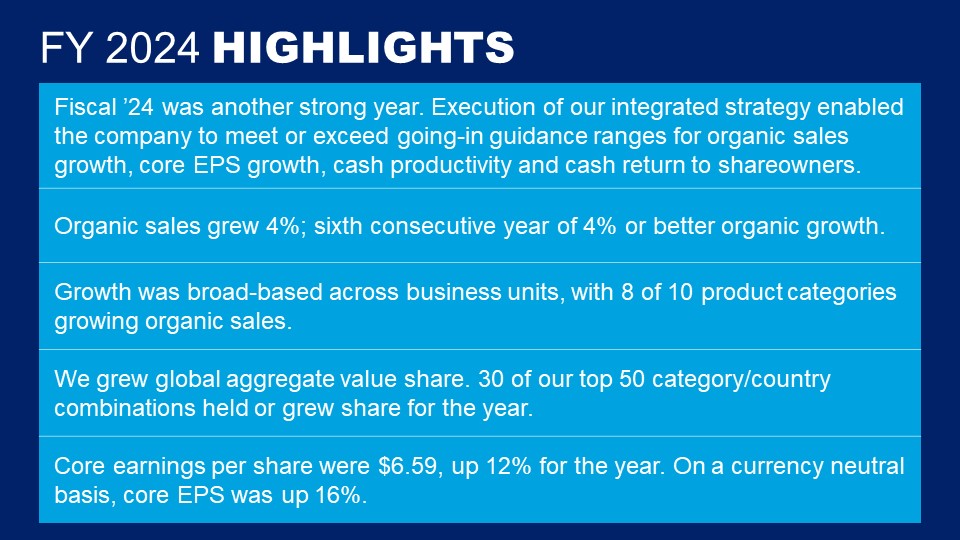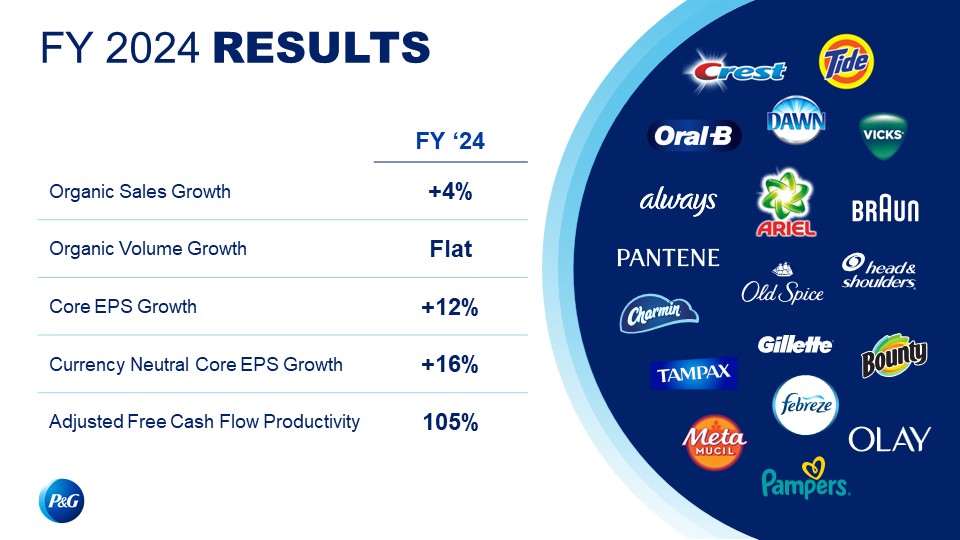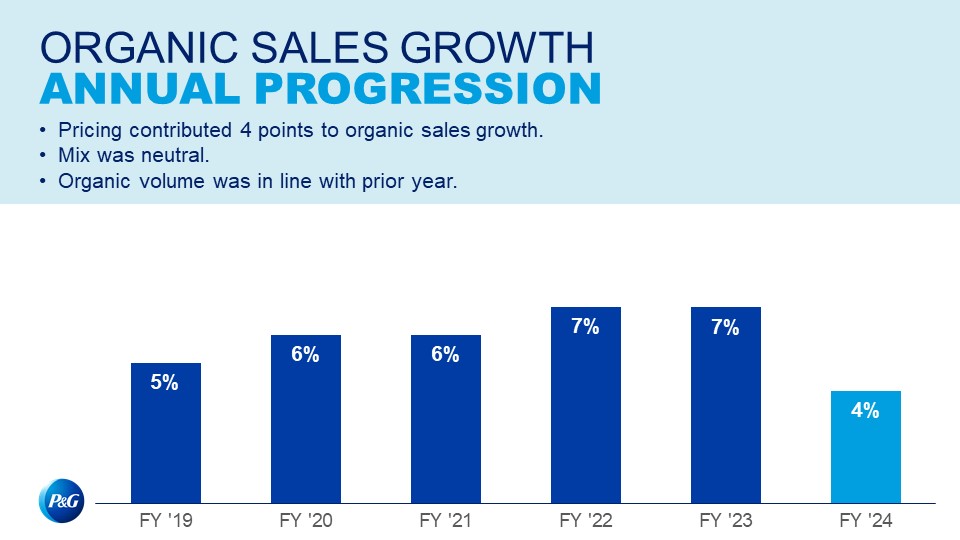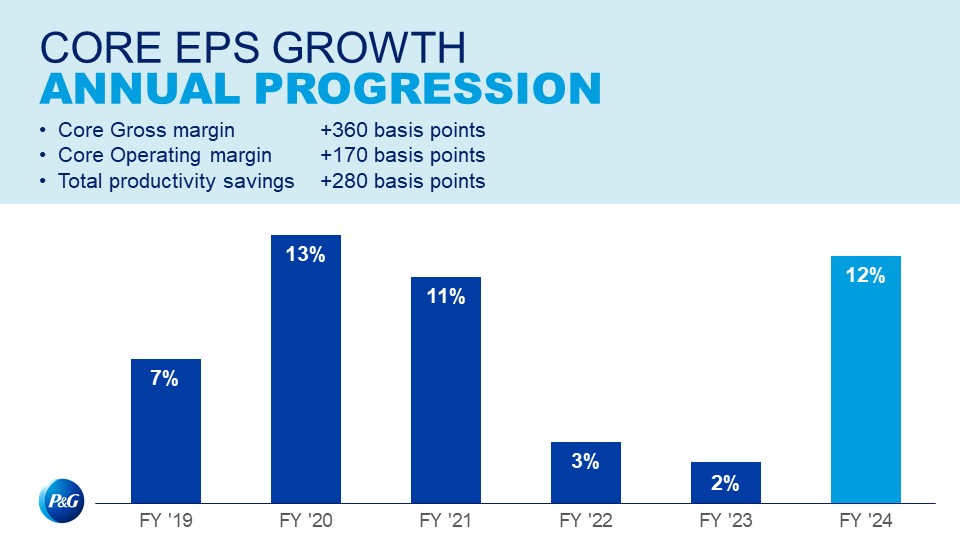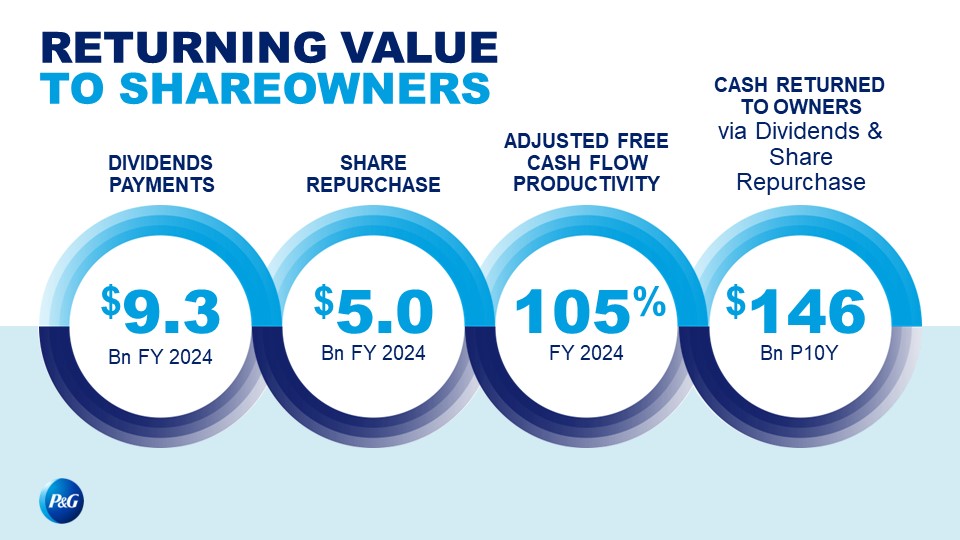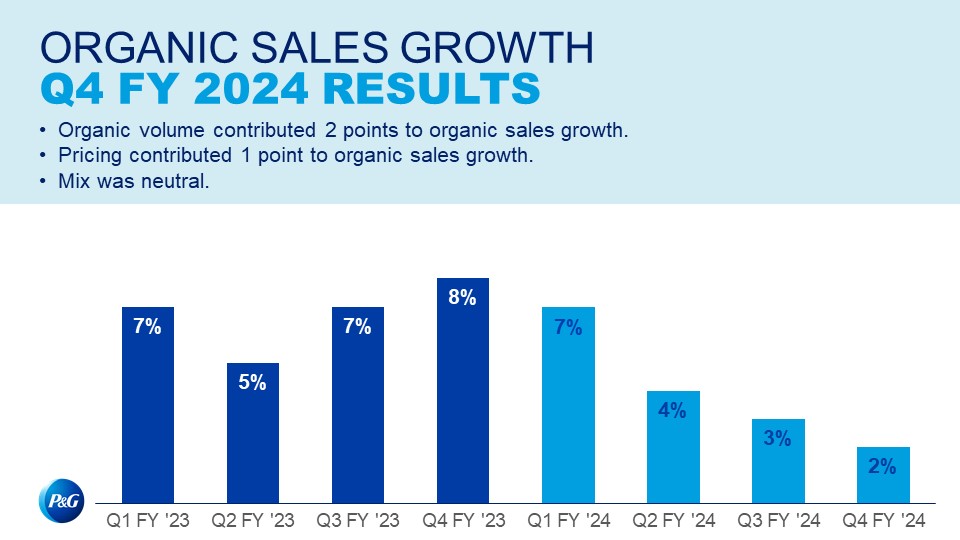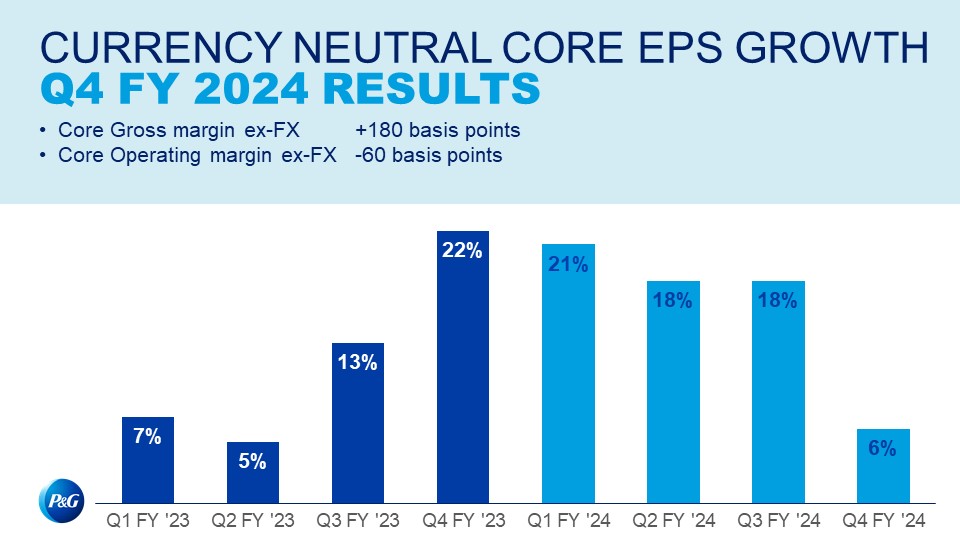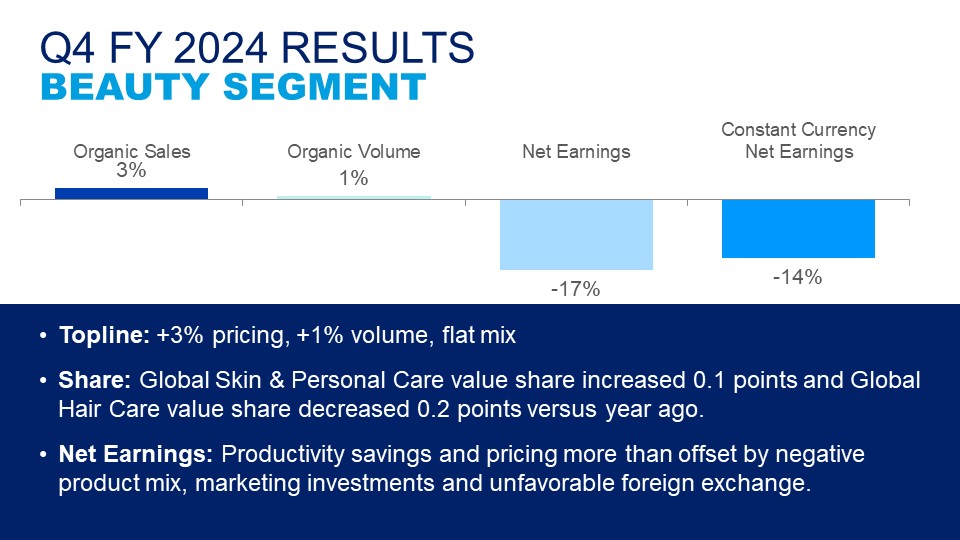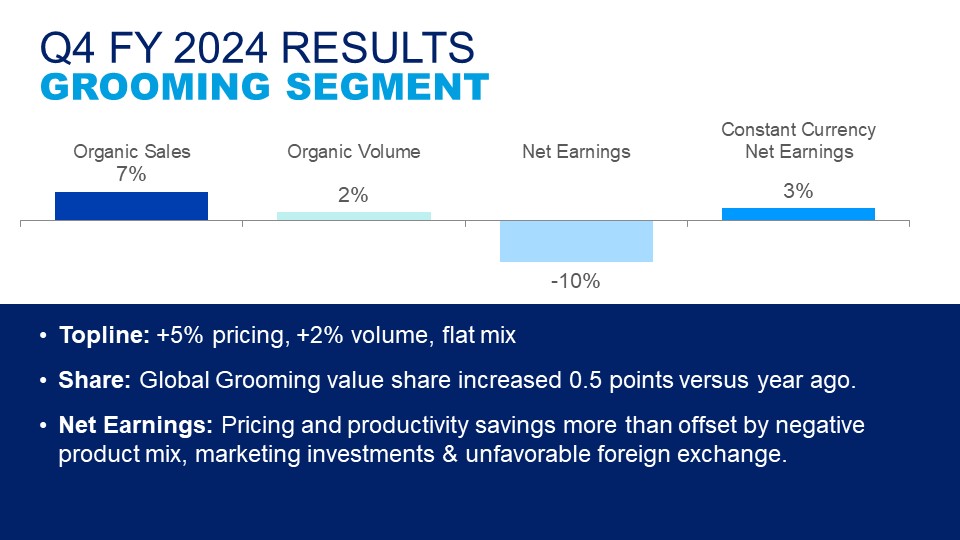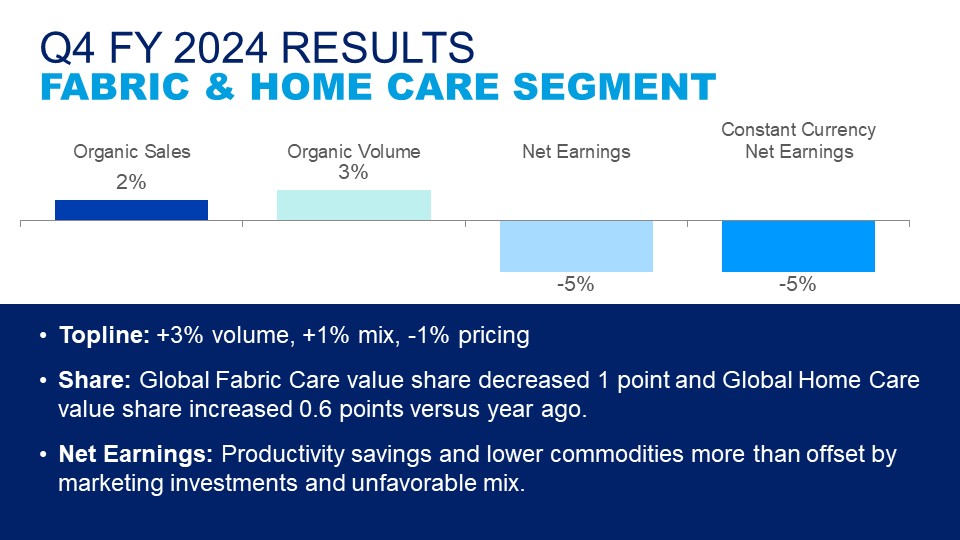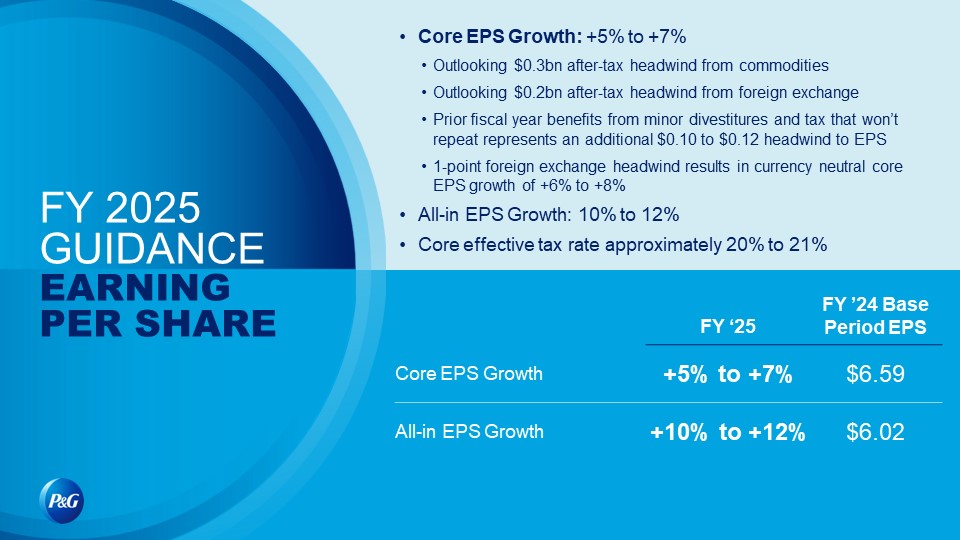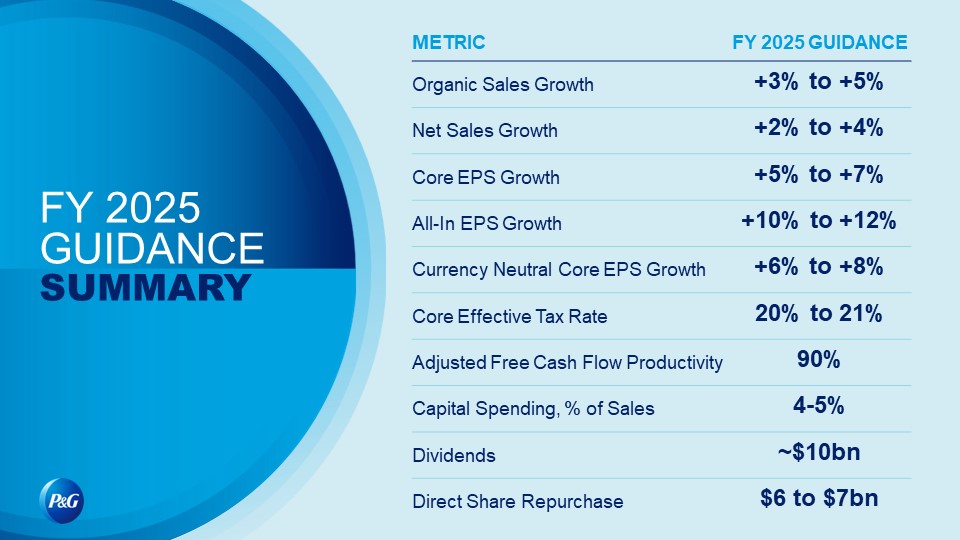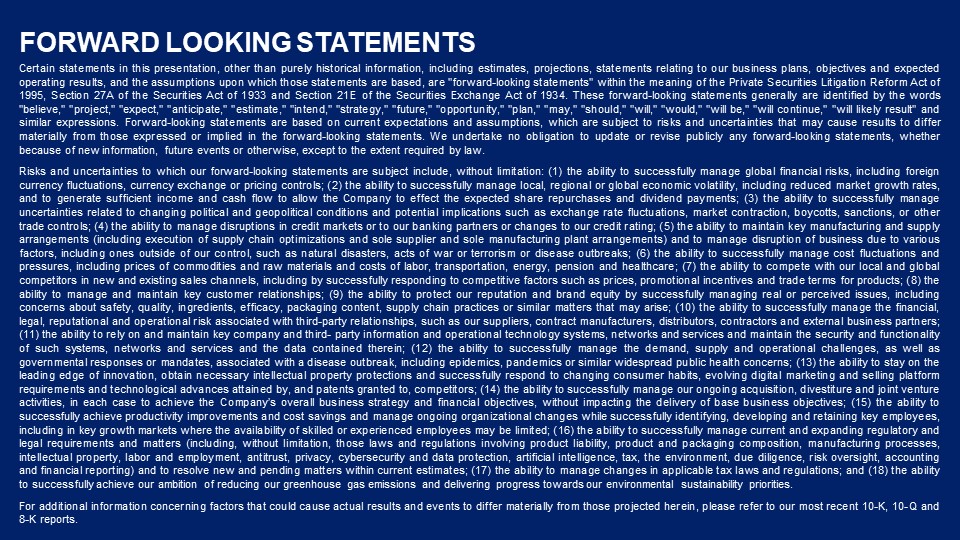Certain statements in this presentation, other than purely historical information, including estimates, projections, statements relating to our business plans, objectives and expected operating results, and the assumptions upon which those statements are based, are "forward-looking statements" within the meaning of the Private Securities Litigation Reform Act of 1995, Section 27A of the Securities Act of 1933 and Section 21E of the Securities Exchange Act of 1934. These forward-looking statements generally are identified by the words "believe," "project," "expect," "anticipate," "estimate," "intend," "strategy," "future," "opportunity," "plan," "may," "should," "will," "would," "will be," "will continue," "will likely result" and similar expressions. Forward-looking statements are based on current expectations and assumptions, which are subject to risks and uncertainties that may cause results to differ materially from those expressed or implied in the forward-looking statements. We undertake no obligation to update or revise publicly any forward-looking statements, whether because of new information, future events or otherwise, except to the extent required by law. Risks and uncertainties to which our forward-looking statements are subject include, without limitation: (1) the ability to successfully manage global financial risks, including foreign currency fluctuations, currency exchange or pricing controls; (2) the ability to successfully manage local, regional or global economic volatility, including reduced market growth rates, and to generate sufficient income and cash flow to allow the Company to effect the expected share repurchases and dividend payments; (3) the ability to successfully manage uncertainties related to changing political and geopolitical conditions and potential implications such as exchange rate fluctuations, market contraction, boycotts, sanctions, or other trade controls; (4) the ability to manage disruptions in credit markets or to our banking partners or changes to our credit rating; (5) the ability to maintain key manufacturing and supply arrangements (including execution of supply chain optimizations and sole supplier and sole manufacturing plant arrangements) and to manage disruption of business due to various factors, including ones outside of our control, such as natural disasters, acts of war or terrorism or disease outbreaks; (6) the ability to successfully manage cost fluctuations and pressures, including prices of commodities and raw materials and costs of labor, transportation, energy, pension and healthcare; (7) the ability to compete with our local and global competitors in new and existing sales channels, including by successfully responding to competitive factors such as prices, promotional incentives and trade terms for products; (8) the ability to manage and maintain key customer relationships; (9) the ability to protect our reputation and brand equity by successfully managing real or perceived issues, including concerns about safety, quality, ingredients, efficacy, packaging content, supply chain practices or similar matters that may arise; (10) the ability to successfully manage the financial, legal, reputational and operational risk associated with third-party relationships, such as our suppliers, contract manufacturers, distributors, contractors and external business partners; (11) the ability to rely on and maintain key company and third- party information and operational technology systems, networks and services and maintain the security and functionality of such systems, networks and services and the data contained therein; (12) the ability to successfully manage the demand, supply and operational challenges, as well as governmental responses or mandates, associated with a disease outbreak, including epidemics, pandemics or similar widespread public health concerns; (13) the ability to stay on the leading edge of innovation, obtain necessary intellectual property protections and successfully respond to changing consumer habits, evolving digital marketing and selling platform requirements and technological advances attained by, and patents granted to, competitors; (14) the ability to successfully manage our ongoing acquisition, divestiture and joint venture activities, in each case to achieve the Company’s overall business strategy and financial objectives, without impacting the delivery of base business objectives; (15) the ability to successfully achieve productivity improvements and cost savings and manage ongoing organizational changes while successfully identifying, developing and retaining key employees, including in key growth markets where the availability of skilled or experienced employees may be limited; (16) the ability to successfully manage current and expanding regulatory and legal requirements and matters (including, without limitation, those laws and regulations involving product liability, product and packaging composition, manufacturing processes, intellectual property, labor and employment, antitrust, privacy, cybersecurity and data protection, artificial intelligence, tax, the environment, due diligence, risk oversight, accounting and financial reporting) and to resolve new and pending matters within current estimates; (17) the ability to manage changes in applicable tax laws and regulations; and (18) the ability to successfully achieve our ambition of reducing our greenhouse gas emissions and delivering progress towards our environmental sustainability priorities. For additional information concerning factors that could cause actual results and events to differ materially from those projected herein, please refer to our most recent 10-K, 10-Q and 8-K reports. FORWARD LOOKING STATEMENTS
The Procter & Gamble Company Regulation G Reconciliation of Non-GAAP Measures
The following provides definitions of the non-GAAP measures used in Procter & Gamble's July 30, 2024 earnings call, associated slides and other materials and the reconciliation to the most closely related GAAP measure. We believe that these non-GAAP measures provide useful perspective on underlying business trends (i.e., trends excluding non-recurring or unusual items) and results and provide a supplemental measure of year-on-year results.
The non-GAAP measures described below are used by Management in making operating decisions, allocating financial resources and for business strategy purposes. These measures may be useful to investors, as they provide supplemental information about business performance and provide investors a view of our business results through the eyes of Management. Certain of these measures are also used to evaluate senior management and are a factor in determining their at-risk compensation.
These non-GAAP measures are not intended to be considered by the user in place of the related GAAP measure, but rather as supplemental information to our business results. These non-GAAP measures may not be the same as similar measures used by other companies due to possible differences in method and in the items or events being adjusted.
The Company is not able to reconcile its forward-looking non-GAAP cash flow and effective tax rate measures because the Company cannot predict the timing and amounts of discrete items such as acquisition and divestitures, which could significantly impact GAAP results.
The following measures are provided:
| 1. | Organic sales growth — page 2 |
| 2. | Core EPS and Currency-neutral Core EPS — page 3 |
| 3. | Core gross margin and Currency-neutral Core gross margin — page 5 |
| 4. | Core operating margin and Currency-neutral Core operating margin — page 5 |
| 5. | Adjusted free cash flow and Adjusted free cash flow productivity — page 6 |
The Core earnings measures included in the following reconciliation tables refer to the equivalent GAAP measures adjusted as applicable for the following items:
| • | Incremental restructuring: The Company has historically had an ongoing level of restructuring activities of approximately $250 - $500 million before tax. Starting in 2012 through fiscal 2020, the Company had a strategic productivity and cost savings initiative that resulted in incremental restructuring charges. On December 5, 2023, the Company announced a limited market portfolio restructuring of its business operations, primarily in certain Enterprise Markets, including Argentina and Nigeria. The adjustment to Core earnings includes the restructuring charges that exceed the normal, recurring level of restructuring charges. |
| • | Intangible asset impairment: In the fiscal year ended June 30, 2024, the Company recognized a non-cash, after-tax impairment charge of $1.0 billion ($1.3 billion before tax) to adjust the carrying value of the Gillette intangible asset acquired as part of the Company's 2005 acquisition of The Gillette Company. In fiscal 2019, the Company recognized a one-time, non-cash, after-tax charge of $8.0 billion to adjust the carrying value of the Shave Care reporting unit. This was comprised of a before- and after-tax impairment charge of $6.8 billion related to goodwill and an after-tax impairment charge of $1.2 billion to reduce the carrying value of the Gillette indefinite-lived intangible asset. |
| • | Charges for early debt extinguishment: During fiscals 2021 and 2018, the Company recorded after-tax charges due to the early extinguishment of certain long-term debt. These charges represent the difference between the reacquisition price and the par value of the debt extinguished. |
| • | Gain on Dissolution of the PGT Healthcare Partnership: The Company dissolved our PGT Healthcare partnership, a venture between the Company and Teva Pharmaceuticals Industries, Ltd (Teva) in the OTC consumer healthcare business, during fiscal 2019. The transaction was accounted for as a sale of the Teva portion of the PGT business; the Company recognized an after-tax gain on the dissolution. |
| • | Anti-Dilutive Impacts: The Shave Care impairment charges in 2019 caused certain equity instruments that are normally dilutive (and hence normally assumed converted or exercised for the purposes of determining diluted net earnings per common share) to be anti-dilutive. Accordingly for U.S. GAAP diluted net earnings per common share, the instruments were not assumed to be converted or exercised. Specifically, certain of our outstanding preferred shares and share-based equity awards were not included in the diluted weighted average common shares outstanding. As a result of the non-GAAP Shave Care impairment adjustment, these instruments were dilutive for non-GAAP earnings per share. |
| • | Transitional Impacts of the U.S. Tax Act: The U.S. government enacted comprehensive tax legislation commonly referred to as the Tax Cuts and Jobs Act (the “U.S. Tax Act”) in December 2017. This resulted in a net charge for the fiscal year 2018. The adjustment to core earnings includes only this transitional impact. It does not include the ongoing impacts of the lower U.S. statutory rate on pre-tax earnings. |
We do not view the above items to be part of our sustainable results, and their exclusion from core earnings measures provides a more comparable measure of year-on-year results. These items are also excluded when evaluating senior management in determining their at-risk compensation.
Organic sales growth: Organic sales growth is a non-GAAP measure of sales growth excluding the impacts of acquisitions and divestitures and foreign exchange from year-over-year comparisons. We believe this measure provides investors with a supplemental understanding of underlying sales trends by providing sales growth on a consistent basis. This measure is also used in assessing the achievement of management goals for at-risk compensation.
Core EPS and currency-neutral Core EPS: Core net earnings per share, or Core EPS, is a measure of diluted net earnings per common share (diluted EPS) adjusted for items as indicated. Currency-neutral EPS is a measure of the Company's Core EPS excluding the incremental current year impact of foreign exchange. Management views these non-GAAP measures as useful supplemental measures of Company performance over time.
Core gross margin and currency-neutral Core gross margin: Core gross margin is a measure of the Company's gross margin adjusted for items as indicated. Currency-neutral Core gross margin is a measure of the Company's Core gross margin excluding the incremental current year impact of foreign exchange. Management believes these non-GAAP measures provide a supplemental perspective to the Company’s operating efficiency over time.
Core operating margin and currency-neutral Core operating margin: Core operating margin is a measure of the Company's operating margin adjusted for items as indicated. Currency-neutral Core operating margin is a measure of the Company’s Core operating margin excluding the incremental current year impact of foreign exchange. Management believes these non-GAAP measures provide a supplemental perspective to the Company’s operating efficiency over time.
Adjusted free cash flow: Adjusted free cash flow is defined as operating cash flow less capital spending and other items as indicated. Adjusted free cash flow represents the cash that the Company is able to generate after taking into account planned maintenance and asset expansion. We view adjusted free cash flow as an important measure because it is one factor used in determining the amount of cash available for dividends, share repurchases, acquisitions and other discretionary investments.
Adjusted free cash flow productivity: Adjusted free cash flow productivity is defined as the ratio of adjusted free cash flow to net earnings excluding the Gillette intangible asset impairment charge and non-cash charge for accumulated foreign currency translation losses related to the substantial liquidation of operations in certain Enterprise Markets, including Nigeria. Management views adjusted free cash flow productivity as a useful measure to help investors understand P&G’s ability to generate cash. This measure is used by management in making operating decisions, allocating financial resources and for budget planning purposes. This measure is also used in assessing the achievement of management goals for at-risk compensation.
1. Organic sales growth:
Three Months Ended
June 30, 2024 | Net Sales Growth | | Foreign Exchange Impact | | Acquisition &
Divestiture Impact/Other* | | Organic Sales Growth |
| Beauty | (1)% | | 3% | | 1% | | 3% |
| Grooming | —% | | 7% | | —% | | 7% |
| Health Care | 3% | | 1% | | —% | | 4% |
| Fabric Care & Home Care | —% | | 1% | | 1% | | 2% |
| Baby, Feminine & Family Care | (3)% | | 2% | | —% | | (1)% |
| Total Company | —% | | 2% | | —% | | 2% |
* Acquisition & Divestiture Impact/Other includes the volume and mix impact of acquisitions and divestitures and rounding impacts necessary to reconcile net sales to organic sales.
Fiscal Year Ended June 30, 2024 | Net Sales Growth | | Foreign Exchange Impact | | Acquisition &
Divestiture Impact/Other* | | Organic Sales Growth |
| Total Company | 2% | | 2% | | —% | | 4% |
* Acquisition & Divestiture Impact/Other includes the volume and mix impact of acquisitions and divestitures and rounding impacts necessary to reconcile net sales to organic sales.
Organic Sales Growth
Prior Quarters
Total Company | Net Sales Growth | | Foreign Exchange Impact | | Acquisition/ Divestiture Impact/Other* | | Organic Sales Growth |
| Q1 FY 2023 | 1% | | 6% | | —% | | 7% |
| Q2 FY 2023 | (1)% | | 6% | | —% | | 5% |
| Q3 FY 2023 | 4% | | 4% | | (1)% | | 7% |
| Q4 FY 2023 | 5% | | 4% | | (1)% | | 8% |
| Q1 FY 2024 | 6% | | 1% | | —% | | 7% |
| Q2 FY 2024 | 3% | | 1% | | —% | | 4% |
| Q3 FY 2024 | 1% | | 2% | | —% | | 3% |
* Acquisition & Divestiture Impact/Other includes the volume and mix impact of acquisitions and divestitures and rounding impacts necessary to reconcile net sales to organic sales.
Organic Sales Growth
Prior Fiscal Years
Total Company | Net Sales Growth | | Foreign Exchange Impact | | Acquisition/ Divestiture Impact/Other* | | Organic Sales Growth |
| FY 2023 | 2% | | 5% | | —% | | 7% |
| FY 2022 | 5% | | 2% | | —% | | 7% |
| FY 2021 | 7% | | (1)% | | —% | | 6% |
| FY 2020 | 5% | | 2% | | (1)% | | 6% |
| FY 2019 | 1% | | 4% | | —% | | 5% |
* Acquisition & Divestiture Impact/Other includes the volume and mix impact of acquisitions and divestitures for all periods and rounding impacts necessary to reconcile net sales to organic sales.
Organic Sales Growth
Guidance
| Total Company | | Net Sales Growth | | Combined Foreign Exchange & Acquisition/Divestiture Impact/Other* | | Organic Sales Growth |
| FY 2025 (Estimate) | | +2% to +4% | | +1% | | +3% to +5% |
* Combined Foreign Exchange & Acquisition/Divestiture Impact/Other includes foreign exchange impacts, the volume and mix impact of acquisitions and divestitures and rounding impacts necessary to reconcile net sales to organic sales.
2. Core EPS and Currency-neutral Core EPS:
| | Three Months Ended June 30 |
| | 2024 | 2023 |
| Diluted EPS | $1.27 | $1.37 |
| Incremental restructuring | 0.13 | — |
| Intangible asset impairment | — | — |
| Core EPS | $1.40 | $1.37 |
| Percentage change vs. prior period Core EPS | 2% | |
| Currency impact to earnings | 0.05 | |
| Currency-Neutral Core EPS | $1.45 | |
| Percentage change vs. prior period Core EPS | 6% | |
Core EPS and Currency-Neutral Core EPS
| | Fiscal Year Ended
June 30 |
| | 2024 | 2023 |
| Diluted Net EPS | $6.02 | $5.90 |
| Incremental restructuring | 0.15 | — |
| Intangible asset impairment | 0.42 | — |
| Core EPS | $6.59 | $5.90 |
| Percentage change vs. prior period Core EPS | 12% | |
| Currency Impact to Earnings | 0.23 | |
| Currency-Neutral Core EPS | $6.82 | |
| Percentage change vs. prior period Core EPS | 16% | |
Current and Prior Fiscal Years
| | | 2024 | 2023 | 2022 | 2021 | 2020 | 2019 | 2018 |
| | Diluted Net Earnings Per Common Share from Continuing Operations, attributable to P&G | $6.02 | $5.90 | $5.81 | $5.50 | $4.96 | $1.43 | $3.67 |
| | Incremental Restructuring | 0.15 | | | | 0.16 | 0.13 | 0.23 |
| Intangible Impairment | 0.42 | | | | | 3.03 | |
| | Early Debt Extinguishment Charges | | | | 0.16 | | | 0.09 |
| | Gain on PGT Dissolution | | | | | | (0.13) | |
| | Anti-dilutive Impacts | | | | | | 0.06 | |
| | Transitional Impact of U.S. Tax Act | | | | | | | 0.23 |
| | Core EPS | $6.59 | $5.90 | $5.81 | $5.66 | $5.12 | $4.52 | $4.22 |
| | Core EPS growth vs prior year | 12% | 2% | 3% | 11% | 13% | 7% | |
| | Currency Impact to Earnings | 0.23 | 0.55 | 0.11 | 0.04 | 0.15 | 0.35 | |
| | Currency-Neutral Core EPS | $6.82 | $6.45 | $5.92 | $5.70 | $5.27 | $4.87 | $4.17 |
| | Percentage change vs. prior period Core EPS | 16% | 11% | 5% | 11% | 17% | 15% | |
Note – All reconciling items are presented net of tax. Tax effects are calculated consistent with the nature of the underlying transaction.
Prior Quarters
| | Q1 FY23 | Q1 FY22 | Q2 FY23 | Q2 FY22 | Q3 FY23 | Q3 FY22 | Q4 FY23 | Q4 FY22 | Q1 FY24 | Q1 FY23 | Q2 FY24 | Q2 FY23 | Q3 FY24 | Q3 FY23 |
| Diluted EPS | $1.57 | $1.61 | $1.59 | $1.66 | $1.37 | $1.33 | $1.37 | $1.21 | $1.83 | $1.57 | $1.40 | $1.59 | $1.52 | $1.37 |
| Incremental restructuring | — | — | — | — | — | — | — | — | — | — | 0.02 | — | — | — |
| Intangible asset impairment | — | — | — | — | — | — | — | — | — | — | 0.42 | — | — | — |
| Core EPS | $1.57 | $1.61 | $1.59 | $1.66 | $1.37 | $1.33 | $1.37 | $1.21 | $1.83 | $1.57 | $1.84 | $1.59 | $1.52 | $1.37 |
| Percentage change vs. prior period Core EPS | (2)% | | (4)% | | 3% | | 13% | | 17% | | 16% | | 11% | |
| Currency Impact to Earnings | 0.16 | | 0.16 | | 0.13 | | 0.11 | | 0.07 | | 0.03 | | 0.09 | |
| Currency-Neutral Core EPS | $1.73 | | $1.75 | | $1.50 | | $1.48 | | $1.90 | | $1.87 | | $1.61 | |
| Percentage change vs. prior period Core EPS | 7% | | 5% | | 13% | | 22% | | 21% | | 18% | | 18% | |
Note – All reconciling items are presented net of tax. Tax effects are calculated consistent with the nature of the underlying transaction.
Core EPS Growth and Currency-neutral EPS
Guidance
| Total Company | Diluted EPS Growth | Impact of Incremental Non-Core Items | Core EPS Growth | Impact of FX | Currency-neutral EPS Growth |
| FY 2025 (Estimate) | +10% to +12% | -5% | +5% to +7% | 1% | +6% to +8% |
3. Core gross margin and Currency-neutral Core gross margin:
| | Three Months Ended June 30 |
| | 2024 | 2023 |
| Gross Margin | 49.6% | 48.4% |
| Incremental restructuring | 0.2% | — |
| Core Gross Margin | 49.8% | 48.4% |
| Basis point change vs. prior year Core gross margin | 140 | |
| Currency Impact to Margin | 0.4% | |
| Currency-Neutral Core Gross Margin | 50.2% | |
| Basis point change vs prior year Core gross margin | 180 | |
| | Fiscal Year Ended June 30 |
| | 2024 | 2023 |
| Gross Margin | 51.4% | 47.9% |
| Incremental restructuring | 0.1% | — |
| Core Gross Margin | 51.5% | 47.9% |
| Basis point change vs. prior year Core gross margin | 360 | |
| Currency Impact to Margin | 0.6% | |
| Currency-Neutral Core Gross Margin | 52.1% | |
| Basis point change vs prior year Core gross margin | 420 | |
4. Core operating margin and Currency-neutral Core operating margin:
| | Three Months Ended June 30 |
| | 2024 | 2023 |
| Operating Margin | 18.9% | 20.3% |
| Incremental restructuring | 0.4% | — |
| Core Operating Margin | 19.3% | 20.3% |
| Basis point change vs. prior year Core operating margin | -100 | |
| Currency Impact to Margin | 0.4% | |
| Currency-Neutral Core Operating Margin | 19.7% | |
| Basis point change vs. prior year Core operating margin | -60 | |
| | Fiscal Year Ended June 30 |
| | 2024 | 2023 |
| Operating Margin | 22.1% | 22.1% |
| Incremental restructuring | 0.1% | — |
| Intangible asset impairment charge | 1.6% | — |
| Core Operating Margin | 23.8% | 22.1% |
| Basis point change vs. prior year Core operating margin | 170 | |
| Currency Impact Margin | 0.8% | |
| Currency-Neutral Core Operating Margin | 24.6% | |
| Basis point change vs. prior year Core operating margin | 250 | |
5. Adjusted free cash flow and Adjusted free cash flow productivity (dollar amounts in millions):
| Three Months Ended June 30, 2024 |
| Operating Cash Flow | Capital Spending | Adjusted Free Cash Flow | Net Earnings | Adjustments to Net Earnings(1) | Net Earnings as Adjusted | Adjusted Free Cash Flow Productivity |
| $5,754 | $(783) | $4,971 | $3,144 | $216 | $3,360 | 148% |
(1) Adjustments to Net Earnings relate to non-cash charge for accumulated foreign currency translation losses due to the substantial liquidation of operations in certain Enterprise Markets including Nigeria.
| Fiscal Year Ended June 30, 2024 |
| Operating Cash Flow | Capital Spending | U.S. Tax Act Payments | Adjusted Free Cash Flow | Net Earnings | Adjustments to Net Earnings(1) | Net Earnings as Adjusted | Adjusted Free Cash Flow Productivity |
| $19,846 | $(3,322) | $422 | $16,947 | $14,974 | $1,242 | $16,216 | 105% |
(1) Adjustments to Net Earnings relate to the Gillette intangible asset impairment charge ($1.0 billion) and non-cash charge for accumulated foreign currency translation losses ($216) due to the substantial liquidation of operations in certain Enterprise Markets including Nigeria.



